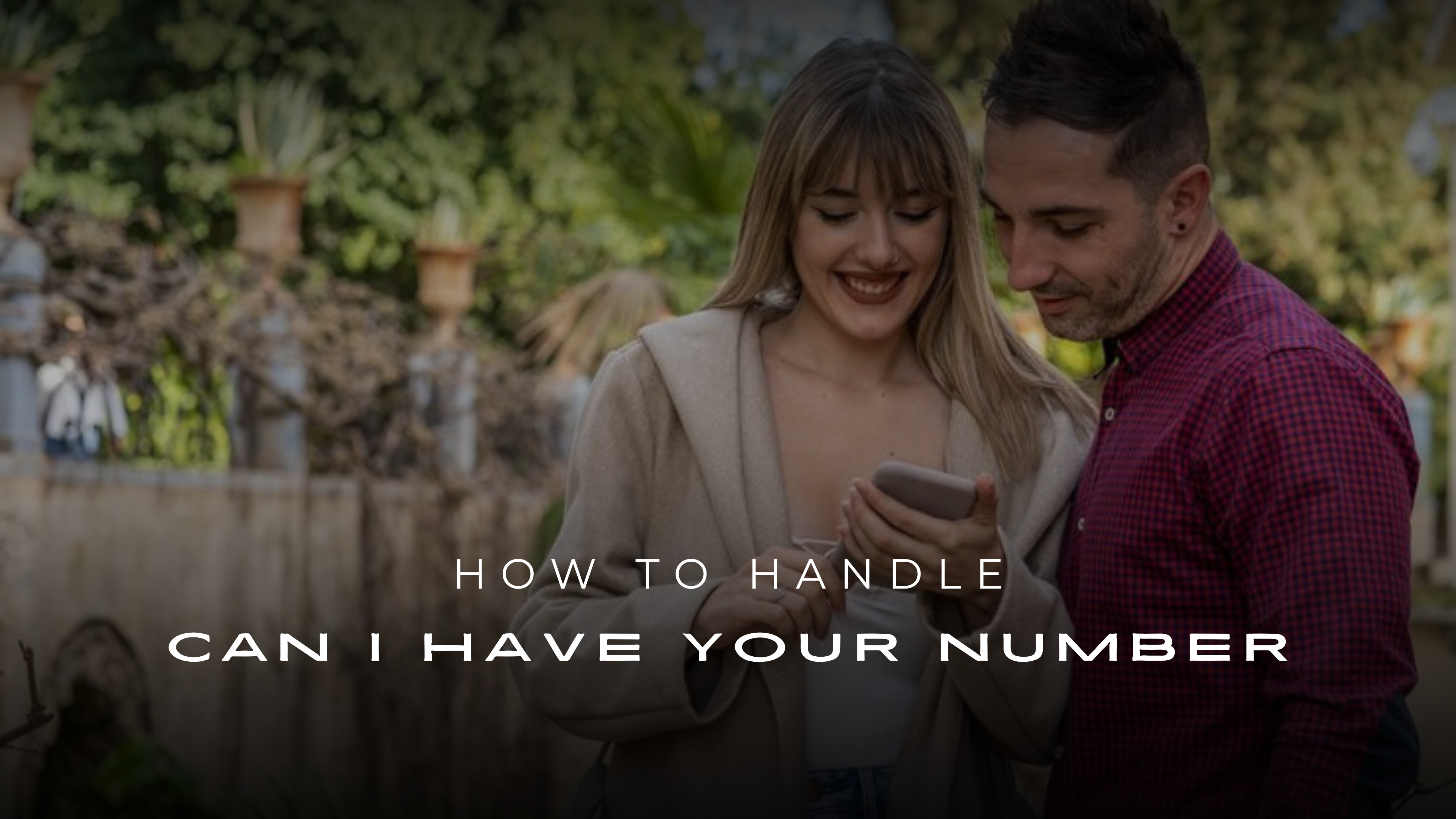Have you ever been in a situation where someone asks, “Can I have your number?” Depending on the context, this question can be flattering, awkward, or downright uncomfortable. Knowing how to handle this question appropriately is crucial for maintaining comfort, safety, and social ease. Let’s explore some strategies and tips for managing this common query gracefully and confidently.
Understanding the Context
Before deciding how to respond, it’s important to understand the context in which the question is asked. Is it a friendly acquaintance, a persistent stranger, or a professional contact? Each scenario requires a different approach.
Setting Personal Boundaries
- Importance of Boundaries
Personal boundaries are essential for protecting one’s well-being and privacy. They help one maintain control over one’s personal information and interactions.
- How to Establish Your Boundaries
Be clear about what you’re comfortable sharing with yourself. If giving out your number makes you uneasy, saying no is perfectly okay. Practice setting these boundaries in less pressured situations to build your confidence.

200+ Replies to “Can I Have Your Number?”
Polite Decline
- Thank you for asking, but I prefer to keep my number private.
- I appreciate your interest, but I’m uncomfortable giving out my number.
- I’m sorry, I don’t give my number to people I just met.
- Thanks for understanding, but I like to keep my number private.
- I hope you understand, but I don’t share my number.
- I’m flattered, but I’m not ready to share my number.
- I prefer to keep my number private. Thank you for understanding.
- I’m sorry, but I haven’t given you my number.
- I appreciate the gesture, but I’m not comfortable sharing my number.
- Thanks, but I’d rather not give out my number.
Humorous Response
- Sure, it’s 867-5309. Just kidding!
- Only if you promise not to text me at 3 a.m.!
- Okay, but I must warn you, my phone is from the ’90s.
- Alright, but expect me to answer at noon.
- I could give you my number, but then I’d have to kill you.
- Sure, it’s 1-800-YOU-WISH.
- I’ll give you my number if you can guess my middle name.
- Do you want my number? You’ll have to solve my riddle first!
- Okay, but my phone only works on Tuesdays.
- Sure, but you’ll need to sign a contract first!
Indirect Refusal
- How about we connect on social media instead?
- I don’t usually give out my number, but we can chat here.
- Why don’t we exchange emails instead?
- Let’s keep in touch through messages for now.
- I’m uncomfortable giving out my number, but I’m happy to talk here.
- We can talk more next time we see each other.
- I’d rather not give out my number, but let’s stay in touch online.
- I prefer to keep my number private. How about messaging here?
- I’m not ready to share my number, but we can chat another way.
- I don’t give out my number, but we can stay connected here.
Conditional Acceptance
- I can give you my number if we get to know each other better.
- Sure, I’ll give you my number if we meet again.
- I’d be happy to share my number after a few more conversations.
- I’m open to sharing my number if we can chat more first.
- I’ll give you my number if we have another great conversation like this one.
- I’ll give you my number if we can meet for coffee next week.
- Let’s hang out a few times, and then I’ll share my number.
- I’ll feel more comfortable giving my number after we talk a bit more.
- I’ll give you my number if we keep having such interesting talks.
- I’d like to know you better before sharing my number. Let’s keep in touch.
Direct Acceptance
- Sure, my number is 555-123-4567.
- Of course, here’s my number: 555-987-6543.
- Sure, you can reach me at 555-456-7890.
- Yes, my number is 555-321-4321.
- Here’s my number: 555-678-1234.
- No problem, my number is 555-876-5432.
- Sure thing, here it is 555-234-5678.
- Yes, my number is 555-432-5678.
- You can call me at 555-345-6789.
- Here you go, my number is 555-123-6789.
Deflecting with a Question
- Why do you want my number?
- What do you plan to do with my number?
- How about we chat here first?
- Can I know more about you before sharing my number?
- Why don’t you give me your number instead?
- What’s your reason for wanting my number?
- What do you need my number for?
- Can we keep in touch through social media instead?
- How do you usually stay in touch with people?
- Why don’t we see if we meet up again and go from there?
Offering an Alternative
- I don’t give out my number, but you can email me.
- I prefer not to share my number, but you can find me on Instagram.
- How about we connect on LinkedIn instead?
- I’d rather not give my number, but you can message me on Facebook.
- Let’s stay in touch through WhatsApp. What’s your number?
- I’m uncomfortable sharing my number, but we can chat on Snapchat.
- Let’s exchange contact info on a messaging app instead.
- I don’t share my number, but you can reach me on Twitter.
- Can we connect through our mutual friends instead?
- I prefer to chat via Discord. Do you use it?
Requesting More Information
- I would like to know more about you first.
- Why do you need my number?
- What’s your name again?
- Why do you want my number?
- How do you usually stay in touch with people?
- What are you planning to do with my number?
- Let’s talk a bit more before I give you my number.
- Do you have a social media profile I can check out?
- Why don’t you give me your number first?
- Can you tell me more about yourself?
Using Humor to Deflect
- Only if you promise not to call me every five minutes!
- I could give you my number, but then I’d delete you.
- Sure, but be prepared for a lot of cat memes.
- Okay, but you’ll need a decoder ring to figure it out!
- Only if you can handle my awful puns!
- I’d give you my number, but my phone is allergic to new contacts.
- Sure, but it’s 867-5309… Just kidding!
- Okay, but you have to answer a riddle first.
- Sure, but my phone only accepts texts written in emojis.
- Alright, but no prank calls at 3 a.m.?
Firm Refusal
- I’m sorry, but I haven’t given out my number.
- I prefer not to share my number.
- I’m not comfortable giving out my number.
- I don’t share my contact information.
- I’d rather not exchange numbers.
- I keep my number private.
- I’m sorry, but I can’t give you my number.
- I’m not giving out my number, sorry.
- I don’t feel comfortable sharing my number.
- I prefer not to share my contact details.
Friendly Decline
- Thanks for asking, but I prefer to keep my number private.
- I’m flattered, but I keep my number private.
- I appreciate it, but I haven’t given out my number.
- Thanks for understanding, but I’d rather not exchange numbers.
- I’m glad you asked, but I like to keep my contact info private.
- I’m sorry, I don’t usually share my number.
- I appreciate your interest, but I’m not giving out my number.
- I’m grateful you asked, but I am uncomfortable sharing my number.
- I’m honored, but I prefer not to share my contact information.
- Thanks, but I’d rather not give my number out.
Suggesting a Public Meeting
- Let’s meet up again next time instead.
- Let’s catch up over coffee sometime.
- Why don’t we continue this conversation over lunch?
- Let’s plan to see each other at the next event.
- We could hang out at that concert next month.
- Let’s meet up at the gym for a workout.
- How about joining us for the movie night next Friday?
- Let’s grab dinner together soon.
- How about we chat more at the next party?
- Let’s catch up at the park next weekend.
Turning the Question Around
- Why do you need my number?
- What made you ask for my number?
- Can I ask why you’re interested in my number?
- How would having my number help you?
- Why don’t you tell me more about yourself first?
- What’s your reason for wanting my contact information?
- Wouldn’t it be easier to connect on social media?
- Do you usually ask for numbers like this?
- Can you explain why my number is important to you?
- Could you share your number instead?
Evasive Response
- I prefer to keep my contact details private.
- Let’s keep in touch another way.
- I’m not comfortable giving out my number at the moment.
- Let’s chat more before exchanging numbers.
- I’d rather not share my number if that’s okay.
- How about we stay connected through social media?
- Let’s see how things go before sharing numbers.
- I’m keeping my contact info private for now.
- I want to get to know you better first.
- Let’s hold off on exchanging numbers for now.
Concerns for Privacy
- I prefer not to share my number for privacy reasons.
- I like to keep my contact information private.
- I’m cautious about sharing my details.
- I value my privacy when it comes to contact information.
- I’m concerned about privacy, so I don’t share my number.
- I prefer not to give my number to people I don’t know well.
- I’m protective of my privacy, especially with my contact info.
- I prioritize privacy, which is why I don’t share my number.
- I’m careful about who I share my contact details with.
- Privacy is important to me, so I avoid sharing my number.
Offering a Business Card
- Here’s my business card with my contact information.
- Let me give you my card instead.
- I have a card with my email and office number.
- Take my card—it has all my contact details.
- I prefer to exchange business cards instead.
- Here’s my card. Feel free to reach out that way.
- I keep my contact info on my business card.
- Here’s my card. You can contact me through that.
- I carry my contact details on my business card.
- I’ll give you my card. It has my work contact.
Sharing a Secondary Number
- I can give you my work number instead.
- You can reach me on my secondary line.
- I have a separate number I use for these situations.
- Here’s a different number you can reach me at.
- You can contact me on my alternate number.
- I have another number I can share with you.
- I keep a separate line for personal contacts.
- I have a backup number I can give you.
- Here’s my secondary number if you need to reach me.
- I’ll give you my other number for now.
Suggesting an App
- How about we connect on WhatsApp?
- Let’s stay in touch through Facebook Messenger.
- You can message me on Instagram.
- We can chat on Snapchat instead.
- Why don’t we exchange contacts on LinkedIn?
- Let’s connect on Telegram.
- We could use Discord to stay in touch.
- How about we communicate on Viber?
- Let’s stay connected through WeChat.
- I prefer to chat on Signal.
Using Politeness and Firmness
- I appreciate your asking, but I prefer to keep my number private.
- Thank you for the compliment, but I’m uncomfortable sharing my number.
- I understand your interest, but I haven’t given you my number.
- I’m flattered, but I prefer not to exchange numbers.
- Thanks for understanding, but I’d rather not share my contact info.
- I value my privacy, so I’m not comfortable sharing my number.
- I’m sorry, but I cannot give you my number.
- I hope you understand, but I’m uncomfortable sharing my contact details.
- I prefer to keep my number private; thank you.
- I’m sorry, but I’d rather not give out my number.
Offering a Non-Verbal Communication
- Hands over a pre-written note with a messaging app ID.
- Gives a business card with contact details.
- Write down an email address on a piece of paper.
- Signals towards a social media profile.
- Points to a QR code linked to a contact method.
- Sends a digital contact card via a phone app.
- Hints at connecting through a mutual friend.
- Nods towards a shared interest group for further communication.
- Offers to connect through a professional networking site.
- Directs to a community forum or group chat for ongoing interaction.
Reading the Signs
- Body Language Cues
Reading body language can provide clues about a person’s intentions. Are they making you comfortable, or do you sense aggression or impatience? Trust your instincts.
- Verbal Cues
Listen to how the request is made. Is it polite and respectful, or does it feel demanding? The tone and wording can help you decide how to respond.
Offering Alternatives
- Suggesting Other Ways to Stay in Touch
If you’re open to staying in touch but not via phone, suggest alternatives like social media, email, or other messaging platforms.
- Social Media vs. Phone Number
Sharing a social media profile can be a safer initial step. It allows you to maintain a degree of separation until you’re more comfortable.
Safety Considerations
Importance of Personal Safety
Your safety should always be a priority. Be cautious about sharing personal information with people you don’t know well.
Tips for Staying Safe
- Trust your gut feelings.
- Use a secondary number or a service like Google Voice.
- Be cautious of sharing your number in public or online forums.
When You Want to Share Your Number
- Assessing Trustworthiness
If you feel comfortable and trust the person, it might be okay to share your number. Consider factors like how long you’ve known them and their behavior.
- Making a Decision
Take your time making a decision. If you’re unsure, it’s better to err on the side of caution.
Handling Persistent Requests
- How to Deal with Pushy Individuals
If someone keeps pushing for your number, remain firm. Reiterate your boundaries, and don’t feel pressured to give in.
- Maintaining Firmness
Use statements like “I’ve already mentioned that I’m uncomfortable sharing my number” to reinforce your stance.
Professional Scenarios
- Navigating the Question at Work
In professional settings, it’s best to keep interactions professional. Offer your business card or work email instead.
- Maintaining Professionalism
Ensure your response is courteous and professional. Avoid sharing personal contact details unless necessary.
Cultural Differences
- How Cultural Norms Affect the Interaction
Cultural norms can influence how such requests are made and perceived. Be aware of these differences and adapt your response accordingly.
- Adapting Your Response
Respect cultural sensitivities but remain true to your comfort levels. It’s okay to decline if it’s against your boundaries politely.
Role-Playing Scenarios
Practicing Your Response
Practice makes perfect. Role-playing common scenarios with friends can help you feel more confident in real situations.
Common Scenarios to Practice
- A stranger at a social event
- A colleague at a work function
- An acquaintance you’re not comfortable with
Tech Tools to Manage Privacy
Apps and Tools for Privacy
Utilize technology to protect your privacy. Apps like Google Voice or burner numbers can help manage who gets your real number.
Utilizing Technology to Stay Safe
- Use privacy settings on social media.
- Consider using messaging apps that don’t require sharing your number.
Conclusion
Navigating “Can I have your number?” can be challenging, especially when met with over 200 different responses. Personal boundaries and comfort levels vary widely. Understanding why someone wants your number and effectively communicating your preferences are key to handling such situations gracefully.
For more insights on managing diverse responses to this question,
explore our article on:
200+ Replies To “Why Do You Want My Number?”
FAQs
Q. What should I do if someone gets angry when I refuse to share my number?
Stay calm and firm. You have the right to your privacy. If they persist or become aggressive, remove yourself from the situation.
Q. Is it okay to give my number if I feel pressured?
No, never give out your number if you feel pressured. Your comfort and safety are paramount.
Q. How can I politely decline without offending the person?
Use polite and respectful language. Offer an alternative like connecting on social media to soften the refusal.
Q. What are some good alternatives to sharing my phone number?
Social media, email, and messaging apps like WhatsApp or Telegram can be good alternatives.
Q. How can I protect my privacy when sharing my number?
Use a secondary number or apps like Google Voice to keep your real number private. Always adjust privacy settings on social media and messaging apps.











Wow, this post has given me useful info and answered some of my questions. I hope to give something back and aid others like you helped me. Feel free to surf my website UY7 about Airport Transfer.